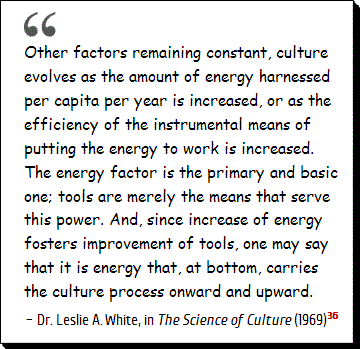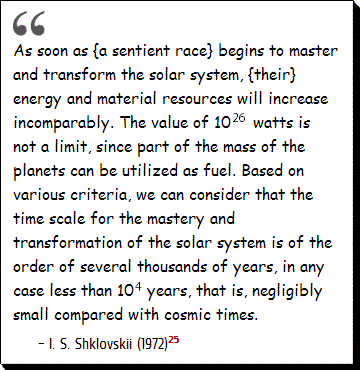© 1979 Robert A. Freitas Jr.
All Rights Reserved
|
|
|
| Science of culture |
It is only in the last decade or two that a true "science of culture" has begun to emerge. The systematic and rational treatment of human civilization as a process has passed in and out of vogue on several occasions during this century. There is considerable hostility in many quarters to the basic notion that cultures must conform to certain basic rules of construction, expression, and evolution, and frequently this has led to what one "hard science" science-fiction writer grumblingly describes as "a couple of anthropologists sitting in a semi-dark room and dictating great thoughts."2857
|
The process of civilization,
as of life, is negentropic. |
But progress is now being made. One of the best efforts to date has been by Dr. Leslie White, a social anthropologist at the University of Michigan in Ann Arbor. In his book The Science of Culture (1969), he presents the beginnings of a theory of culture which is utterly fascinating from a xenological point of view.36
| Three subsystems of culture |
Dr. White suggests that all civilization is founded upon, and determined by, the sources of energy which it controls. The processes of society are in some sense "powered" by energy. He goes on to propose that any cultural system — human or extraterrestrial — may be divided into three fundamental subsystems; the technological, the sociological, and the ideological.
- The technological subsystem is comprised of all the physical, mechanical, biological, and chemical instruments that are available to sentient members of the culture, for the purpose of manipulating matter. Technology is the sum total of a race's material environment, together with the instruments of manipulation and the techniques of their use.
- The sociological subsystem consists of the various interpersonal relation ships between members of a culture. These may be expressed in collective as well as individual patterns of behavior, psychology, and modes of social conduct.
- The ideological subsystem is made up primarily of symbolic articulations of ideas, beliefs, attitudes and knowledge. Cultural ideology encompasses the philosophy, artistic forms, patterns of logic, and epistomologies peculiar to a given society.
| The cultural pyramid |
How are these three cultural subsystems interrelated? According to Dr. White, the rigors of existence (the demand for food, shelter, protection, companionship) can only be met by resorting to technology. This technology may be extremely primitive — stone knives, bearskins, and a blazing campfire — but it is technology nevertheless. Social systems are subsidiary, described by White as "the organized effort of {sentient} beings in the use of the instruments of subsistence, offense and defense, and protection." Philosophical systems are the means by which technological and social experience finds its interpretation. In fact, there is a type of philosophy appropriate to any conceivable class of technology:
|
Figure 15.1 The Cultural Pyramid Theory of Civilization36 |
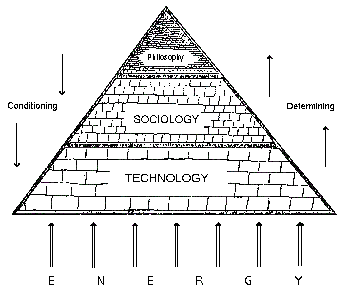 |
A pastoral, agricultural, metallurgical, industrial, or military technology will each find its corresponding expression in philosophy. One type of technology will find expression in the philosophy of totemism, another in astrology or quantum mechanics. … Social systems are therefore determined by technological systems, and philosophies and the arts express experience as it is defined by technology and refracted by social systems.36
We may imagine a pyramid, grounded in energy and constructed in three tiers (Figure 15.1).
Each tier represents one of the basic cultural subsystems which, in the aggregate, comprise the entire civilization. Leslie White elaborates on the idea:
We may view a cultural system as a series of three horizontal strata: the technological layer on the bottom, the philosophical on the top, the sociological stratum in between. These positions express their respective roles in the culture process. The technological system is basic and primary. Social systems are functions of technologies; and philosophies express technological forces and reflect social systems. The technological factor is therefore the determinant of a cultural system as a whole. It determines the form of social systems, and technology and society together determine the content and orientation of philosophy. This is not to say, of course, that social systems do not condition the operation of technologies, or that social and technological systems are not affected by philosophies. They do and are. But to condition is one thing; to determine, quite another.36
| Intelligence and technology |
As Freeman Dyson has often pointed out, a sharp distinction may be drawn between intelligence and technology. One needn‘t imply the other. That is, it's easy to imagine a society of intelligent lifeforms with little or no particular interest in advanced technology.80 But White's cultural subsystems must be given broad interpretation if they are to be applied to extraterrestrial races. "Technology," for instance, may have an organic rather than an inorganic basis.389 Instead of mechanical devices and machines, alien technology may consist of trained animals, slave labor, {tip title="Architectural Coral" content="A structure grown to a specific shape using small coral-like organisms."}architectural coral{/tip} and so forth.
|
"Technology," for instance, may have
an organic rather than an inorganic basis. Instead of mechanical devices and machines, alien technology may consist of trained animals, slave labor, architectural coral and so forth. |
How does this relate to energy?
| The process of civilization is negentropic |
The business of life is to accumulate information and complexity. This is accomplished by using energy to suck in data from the natural environment and build the elaborate structure represented by a living organism. The process of culture, though on a different plane, serves an analogous, function. By absorbing information from the social environment, an aggregation of organisms can build an intricate social structure by the proper application of energy and tools. Just as a living being is a highly complex arrangement of individual molecules, so is a society an intricate association of individual organisms. The process of civilization, as of life, is negentropic.
Cultural development, in the very widest sense, thus is a product both of energy and of technology:
Culture confronts us as an elaborate thermodynamic, mechanical system. By means of technological instruments energy is harnessed and put to work. Social and philosophic systems are both adjuncts and expressions of this technologic process. The functioning of culture as a whole therefore rests upon and is determined by the amount of energy harnessed and by the way in which it is put to work.36
The remainder of this chapter is devoted to the general evolution and utilization of sources of energy by extraterrestrial cultures and races anywhere in the Universe. The following four chapters detail many of the possible alien technological advances, thus completing our discussion of the foundation of Dr. White's three-tiered "cultural pyramid." The last four chapters in Part Three consider the more speculative — and perhaps more interesting — social and philosophical upper strata we may discover among extraterrestrial civilizations elsewhere in space.
|
Figure 15.2 The Night-time View of the Eastern United States, as Seen from Space2603 |
 The thermal burden of energy usage on Earth is a planetary, not local, issue. |
A primitive intelligent alien race, slowly evolving and spreading across the face of its native world, eventually will discover and utilize a wide variety of elementary energy supplies. In the beginning, such creatures would rely mainly on natural sources such as hot springs, fires set by lightning, and their own muscle power.
But soon their intelligence, and the Principle of Economy, would impel them to develop new and easier ways to generate and harness energy. They‘d learn to set their own fires, and how to control them. Animals might be harnessed for transportation, hauling, and agricultural activities. Better fuels, such as coal or natural oil secured from local tar pits, would replace wood in campfires.
| Incubation period of growth |
On our own home planet, this early period was marked by a relatively slow growth in worldwide energy usage. The increase amounted to no more than perhaps 0.3% per year, a doubling time of about 200 years. The speed at which basic resources could be pressed into service, with primitive technology and finite manpower, was extremely limited. Such an early "incubation period" of leisurely growth should be common during the first stages of cultural evolution on any world.
It is entirely possible that ETs on some planets may call a halt, or even reverse, this upward trend in energy consumption. This does not necessarily imply an immediate halt to all technological development — for instance, the culture may simply be shifting its attention from energy-intensive projects to information-intensive ones. However, it does place rather stringent limitations upon the material achievements to which the society may aspire. Without abundant energy, an economy of scarcity management is virtually inevitable.
Finding this prospect rather unattractive, and driven onward by the curiosity and aggressiveness that enabled them to take dominion over their world, many intelligent extraterrestrial races would seek to further improve both the sources and the distribution of power.
On Earth, the widespread initiation of fossil fuel burning (stored solar energy) provided a powerful new source of abundant energy. While great effort was required to harvest tiny amounts of power from wind and water, a tiny bit of oil or natural gas went a long way. In addition, steam and electricity came into their own during the last two centuries of human history. There was getting to be an abundance of raw energy, powerful ways of harnessing it to perform useful work, and efficient means of transmitting it over great distances. The dawn of global culture was at hand (Figure 15.2).
|
In the last two centuries, humanity has
maintained a 3% per year growth rate in energy consumption, a full order of magnitude above the early stages of cultural evolution on Earth. per capita energy production has leapt from about 30 watts/person in ancient times to nearly 2000 watts/person today. as much energy artificially as is received at the planet's surface from its sun |
In the last two centuries, humanity has maintained a 3% per year growth rate in energy consumption, a full order of magnitude above the early stages of cultural evolution on Earth. The doubling time is now measured in decades rather than in centuries. Let's see exactly what this means.
It is believed that the Roman Empire, at the height of its expansive construction and military activities, annually consumed power at a rate roughly equivalent to 3 × 109 watts (1 watt = 1 joule/second). Nearly two millenia later, humanity has increased its energy usage a thousandfold. By 1975, global power consumption reached about 7 × 1012 watts. In only two thousand years, mankind's per capita energy production has leapt from about 30 watts/person in ancient times to nearly 2000 watts/person today.
Xenologists want to know whether or not energy usage will also increase exponentially among alien cultures, as it appears to have done here. Perhaps more interesting and germaine, however, is the following related query: Are there any limits to growth, assuming the ETs adopt an expansionist philosophy?
| Three factors delimiting accessible energy |
It turns out, not surprisingly perhaps, that there do exist very definite limits to growth for any culture that remains confined to the surface of a single planet. There are three fundamental factors which delimit the quantities of energy accessible to a sentient race:
- Availability
- Efficiency
- Planetary carrying capacity
|
It is estimated that if all the deuterium
in Earth's seas were collected and burned in fusion power stations, it would supply all our energy needs at the present rate of consumption for the next 5-10 billion years — roughly the expected lifetime of Sol. |
Our first consideration is the availability of a given energy resource. In general, sources compete with one another depending on their relative scarcity or abundance. To take one trivial example, an alien culture located on a world with little water and strong winds might be expected to place greater emphasis on the development of windmills rather than waterwheels or dams.
A corollary to the fact that a civilization is planetbound is the inevitable finiteness of all resources. There is only so much wind, water, geothermal steam, wood, fossil and nuclear fuels at the surface of a world. Once the population of an extraterrestrial culture has expanded to the point where these resources are in danger of exhaustion, the civilization faces drastic modification, degeneration, or possibly even extinction on a global scale. Such is the early and quite predictable result of sole reliance upon nonrenewable sources of energy.
| Nuclear fusion |
Fortunately, there exist two sources which should be available to all ET societies and which are virtually inexhaustible. First, there is nuclear fusion. This involves mashing together two atoms (usually of hydrogen) which yields a single heavier atom plus lots of energy. About one hydrogen in every 6000 in ordinary seawater is deuterium, the most likely hydrogen isotope to be used in controlled thermonuclear power generation. It is estimated that if all the deuterium in Earth's seas were collected and burned in fusion power stations, it would supply all our energy needs at the present rate of consumption for the next 5-10 billion years — roughly the expected lifetime of Sol.
An alien civilization that opts for fusion power may expect to have enough energy to endure over geological timescales provided there is no growth. If there are oceans of water sufficient to spawn life, there will probably also be enough deuterium to provide all "Type I"* planetbound cultures with virtually inexhaustible energy.**
| Solar power |
The other major energy source available to planetary cultures is solar power. Unless blocked by a thick cloud cover, filtered out by the atmosphere, or attenuated by great distances, radiative energy from the stellar primary can serve as a bountiful and virtually infinite "renewable" source of power. Since stars in habitable solar systems may be expected to have lifetimes measured in eons, a Type I extraterrestrial civilization could again expect a long healthy existence before its energy supply ran out.
So on the question of availability, a large-scale Type I planetary culture should ultimately benefit most from either deuterium fusion power or solar fusion power.
* Dr. N.S. Kardashev, a well-known Russian astrophysicist currently associated with the Institute for Cosmic Research at the Soviet Academy of Sciences in Moscow, devised a particularly fruitful classification scheme which includes all conceivable ET civilizations and is based on system-wide energy consumption.1320 However, Kardashev limited his analysis to the energy available for the purpose of interstellar communication between alien cultures. In this book the original concepts are broadened to provide a general taxonomy for all extra-terrestrial civilizations — whether communicative or not.
** Cultures native to planets with ammonia or methane oceans similarly will have an abundance of deuterium fusion fuel at their disposal. Inhabitants of worlds with sulfur or liquid carbon dioxide seas will not be so fortunate.
|
Table 15.1 Conversion of Matter into Energy: A Comparison of Efficiencies |
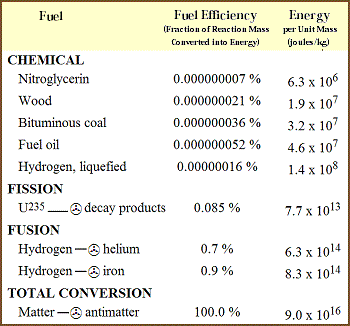 |
The second consideration involves the question of the efficiency of the particular energy resource chosen. Since the technology of a civilization limited to the surface of a single world will ultimately experience severe restrictions on its finite resources, it is important to make the best use possible of what little is available.
|
All energy, whether from fusion, fission,
or chemical reactions, ultimately derives from the conversion of a tiny bit of matter into heat, light, sound, etc. |
Earlier in this century, the late Albert Einstein demonstrated that mass and energy are interchangeable. According to the famous E = mc2, a given amount of matter (m) is exactly equivalent to a certain quantity of energy (E). (The constant of proportionality, c2, is the speed of light, squared.) All energy, whether from fusion, fission, or chemical reactions, ultimately derives from the conversion of a tiny bit of matter into heat, light, sound, etc.
| Conversion of matter into energy |
If their civilization is to long endure, ETs must find the most efficient means for converting mass into energy. Table 15-l provides a representative sampling of various common and theoretical energy sources available to Type I planetary cultures on any world in our Galaxy. In each case the efficiency is calculated, based on the fraction of matter which is changed into usable energy. The most efficient is "total conversion" (100% of the matter goes to energy), but it is difficult to imagine the cheap production of sufficient quantities of antimatter to make this process competitive with thermonuclear fusion.
Indeed, fusion appears to be the most efficient energy generation technique for which the fuel is exceedingly abundant. Once again, both deuterium fusion power and solar fusion power qualify as most efficient. So on the basis of the two factors we‘ve looked at, it is a pretty sure bet that advanced Type I alien cultures will adopt either or both of these techniques.
|
Figure 15.3 Curve of Growth of Technological Energy Usage for a Typical Emergent Type I Civilization: Humanity |
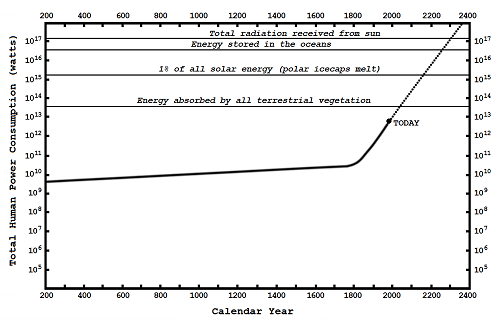 |
But even using the most efficient, abundant sources of energy, planetbound societies cannot continue to expand indefinitely. This is because of the third critical limiting factor: Planetary carrying capacity. The history of our own planet is typical.
In the past century, world energy production has escalated at an average rate of 3% per annum. Approximately every twenty years, human power consumption doubles. In 1975 we used 7 × 1012 watts. If the historical 3% growth rate is maintained, then by the year 2300 A.D., mankind's energy budget will be up to 2 × 1017 watts. Why is this significant? Simply because 2 × 1017 watts is also the total power received from Sol on planet Earth. To sum up, by 2300 A.D. humanity will be generating as much energy artificially as is received at the planet's surface from its sun (Figure 15.3).
| Growth of technological energy usage |
We will then face the most critical "energy crisis" in the history of Earth. Rather than a crisis of scarcity, however, it will be a crisis of overabundance.
All forms of energy — electrical, thermal, mechanical, nuclear — ultimately return to the biosphere in a single degraded form: Heat. Such thermal pollution can rapidly reach catastrophic proportions. As more and more energy — heat — is liberated at the planetary surface, the global temperature begins to rise and the precarious energy balance of the biosphere begins to suffer irreversible damage.
| Hypsithermal catastrophe |
At what point in the development of a Type I civilization will this ultimate "hypsithermal catastrophe" occur? Certainly by the time artificial energy production equals total solar influx, the planet will have suffered serious ecological damage.29 Earth, for instance, would no longer be inhabitable by humans, our lush green world converted into a stewing, steamy hellhole much like Venus. Most experts believe that irreversible destruction of environmental equilibrium would occur at far lower levels of energy production. Conservatives usually draw the line at the photosynthetic energy limit, or the total solar energy fixed by green plants worldwide. This is only about 4 × 1013 watts.
|
Most experts believe that irreversible destruction
of environmental equilibrium would occur at far lower levels of energy production. Conservatives usually draw the line at the photosynthetic energy limit, or the total solar energy fixed by green plants worldwide. This is only about 4 × 1013 watts. |
The best guess seems to be about 1% of the total solar influx as the critical limit.29, 688 This is about 5% of the energy stored in Earth's hydrosphere, and would probably be sufficient to melt the polar icecaps and thoroughly disrupt the entire ecology. On planets with smaller oceans, or with non-water oceans, the climatic turnover point might occur far sooner.
We estimate, therefore, that the maximum upper limit of artificial energy generation for any Type I planetary culture limited to a single world in our Galaxy is roughly 1015 watts.
|
|
|
| Spacefaring cultures |
In the earliest stages of social evolution, alien societies will be pretty much restricted to the surface of their planet. Type I civilizations are defined as those which consume power at the carrying capacity of the planet. Such cultures are limited to the energy obtainable on a single world.
We've seen that planetbound societies can have a long and healthy existence, and may expect to survive for eons barring some unusual major global catastrophe of some kind. But this imposes rather stringent limits to growth on planetary cultures. The price that must be paid for stability and long-term survival on the limited surface of a single world is energetic stasis. This may well lead to cultural stagnation.
Alien races may discover that the only escape from this trap is to move out into space. A Type I society will remain one forever, until and unless it becomes spacefaring.
| Space industrialization |
With the first flights of the American space shuttle, humanity has taken the first tentative step in the evolution from a planetbound Type I to a spacefaring Type II stellar culture. In the centuries to come, space industrialization will proceed with vigor as man becomes more aware of the countless ad-vantages of space-based manufacturing. Of these, the two most highly significant benefits for long-term, large-scale heavy industrial development are vast size and vast energy.
| Giant artifacts |
First, whether in orbit around the home planet or swinging freely in circumsolar territory, physical stresses on material structures are always minute. For this reason, giant artifacts which would be impossible on the surface of a planet will be commonplace in space. Flimsy constructions many tens of kilometers in diameter are possible even with present-day human technology! Huge factories and physical plants may be assembled. Once manufacturing activities in orbit reach a point of relative self-sufficiency — a kind of economic "critical mass" — further expansion will be breathtakingly rapid.
| Energy abundance |
Second, habitats lofted to planetary or solar orbit will find a vast abundance of solar energy. A single world intercepts only a tiny fraction of the entire solar output, less than one one-billionth of the total. But the spacefaring Type II civilization can collect energy from anywhere on a theoretical spherical shell surrounding the central star — a potential energy preserve perhaps ten or eleven orders of magnitude greater than that available at the surface of the home world.
|
Dyson Sphere An almost solid sphere of artifacts envelops |
| Dyson Sphere |
The swarm of technological artifacts orbiting in successive shells around the primary will grow thick as development proceeds. These space factories and habitats ultimately will enclose and capture virtually the entire stellar energy output. This amounts to what xenologists usually call a "Dyson Sphere." Originated by Freeman Dyson at Princeton, the Dyson Sphere is the end result of full space industrialization by a Type II civilization. An almost solid sphere of artifacts envelops the sun, absorbing and directing each watt to the purposes of the gargantuan interplanetary industrial complex.
| Dyson limit |
But even solar energy is not limitless. All spacefaring cultures ultimately must run afoul of the "Dyson limit" — the sum total of all energy emitted by the home star. This is, in some sense, the "carrying capacity" of the entire solar system. Even if the jovian planets are disassembled and cannibalized for fusionable hydrogen, the Dyson limit cannot be much exceeded without sacrificing cultural longevity (e.g., by cannibalizing the home star itself).
How long will it take for an intelligent species to evolve from a planet-bound Type I culture to a spacefaring Type II civilization pressing fitfully against the Dyson limit?
| Transition time-scale |
A typical sun of the habitable variety illuminates alien transsolar space with about 1026 watts of power. Assuming a modest 3% per year growth rate in the interplanetary industrial complex, a Type I civilization (1015 watts) could make the transition to a fully industrialized Type II civilization (1026 watts) in a mere 900 years. Even if we take the incredibly conservative primitive growth rate of 0.3% per year, the transition is accomplished in just 9000 years — long by human standards but only the wink of an eye on geological and evolutionary timescales. We know that it has taken humanity about 10,000 years since the invention of agriculture and basic toolmaking to build a planetary culture, so the estimates above are certainly reasonable.
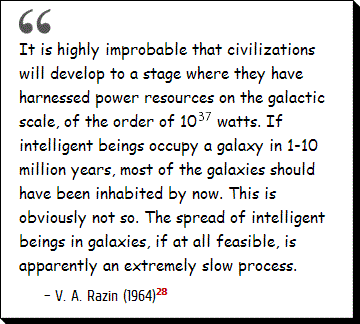 |
| Beyond the Dyson limit |
Extraterrestrial societies, frustrated by the Dyson limit, may push outward still further, spreading their influence from stellar system to stellar system across their galaxy. In time, such a culture — comprised of many millions or even billions of Type II civilizations — may come to dominate the entire galactic corpus. Such a "Type III civilization" could be capable of diverting the power of a hundred billion thermonuclear stellar furnaces to its own cooperative purposes.
|
Type III culture at its peak |
| Synergistic interaction |
The nature of galactic community is very much dependent upon the peculiar aspects of the physical environment. Interstellar distances are vastly greater than interplanetary ones. While a Type II culture might evolve along the lines suggested above (filling transsolar space with the artifacts of industrialization and commercial development), the endless empty regions between stars are unlikely ever to be similarly occupied. Rather, the typical Type III civilization most likely will consist of a collection of Type II civilizations. A synergistic interaction will take place giving rise to a hybrid galactic culture, a melting pot of countless millions of worlds.
| Archipelago of solar systems |
A galactic community may resemble a mammoth archipelago of solar system societies, a multitude of civilized islands separated by the vastness of the oceans of space. Despite this wide dispersion, a Type III culture at its peak would command the power of a hundred billion suns — upwards of 1037 watts. Longevity could be measured in hundreds of eons.
| Transition time-scale |
The time required for galactic civilization to expand to its full potential depends on the assumptions we make. Xenologists hesitate to use a simple exponential extrapolation of the 3% growth rate, because the spatial scale of interstellar expansion is qualitatively different from planetary and interplanetary scales.
|
A galactic community may resemble a mammoth
archipelago of solar system societies, a multitude of civilized islands separated by the vastness of the oceans of space. This is within the limits even of a lowly Type I
society such as our own. The 300-meter dish at Arecibo, Puerto Rico, could communicate with its twin located almost anywhere in the Milky Way. |
If we assume, for example, that the galaxy is teeming with sentient life forms, and that none have advanced beyond the Type II stage of development, then direct interstellar colonization by any one race requires war and imperialism and so is probably not a viable ethical alternative. In this case, cultural unification will be accomplished by an exchange of valuable information and ideas using radio waves or laser beacons whose messages travel at the speed of light. This is within the limits even of a lowly Type I society such as our own. The 300-meter dish at Arecibo, Puerto Rico, could communicate with its twin located almost anywhere in the Milky Way. Clearly, Type II cultures will have the energy to transmit vast quantities of data to their interstellar neighbors.
| Cultural integration |
The typical spiral galaxy spans perhaps 100,000 light-years, so the fastest news can travel from one end to the other is about 100,000 years. If we allow for search and acquisition (first you have to find your neighbors), and for the probability that at least ten exchanges would likely be necessary for cultural integration and homogenization,15 then we find that a unified polyspecies galactic civilization might conceivably begin to take form after only about a million years.*
| United galactic culture |
On the other hand, what if we assume that the galaxy in question is not teeming with life? Perhaps it consists of a few scattered Type I societies, an occasional and very rare emergent Type II culture, with the great bulk of all galactic real estate consisting primarily of undeveloped planetary systems. In this case, preemptive colonization efforts by one of the Type II societies might be appropriate. This ultimately will lead to a "united" galactic culture under the leadership of a single sentient race.
|
While this period seems fantastically long by
human standards, we must remember that the potential lifespan of a galactic civilization should run into the hundreds of billions of years. |
| Colonization |
How long might this take? We might imagine that a highly industrialized stellar culture could launch a large interstellar fleet of colony starships to nearby suns. They'd take along the basic implements which would enable them to set up a thriving planetary civilization. It may require 103-104 years to tame and populate the new solar system, and to build another budding Type II community around the new star. Only after the position of the original colony was secure could the pioneers seriously consider the possibility of dispatching a colonization armada of their own.
The subjugation of the galaxy would thus proceed in a series of waves, pulsing at thousand-year intervals. The alien race could sail the sea of stars at an average rate of perhaps 0.001 light-years of penetration per year. A single aggressive species could dominate an entire galaxy in less than ten million years.
While this period seems fantastically long by human standards, we must remember that the potential lifespan of a galactic civilization should run into the hundreds of billions of years. The initial colonization period represents less than 0.01% of the total lifetime of the Type III monospecies culture in question.
* While it's true that the use of tachyon communications might greatly reduce this "cultural incubation" time, it is also true that the faster a tachyon beam travels, the lower is its maximum theoretical bit rate.3119 The advantages of speed thus may be outweighed by the disadvantage of lower information transferral.
 |
|
Herculean projects
|
Finally, we must mention the possibility of Type IV civilizations, intergalactic cultures spanning the breadth and width of the Universe.
Such a community would commingle the individual cultures of a billion galactic associations, and might command the power of a billion trillion suns — perhaps 1047 watts.
A universal civilization could seriously consider attempting such truly Herculean projects as changing the structure of spacetime, the deliberate slowing or reversal of entropy in our universe to achieve ultimate immortality, or the colonization of other universes (if they exist).
